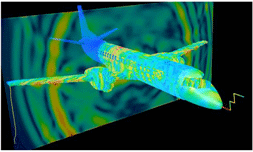KTH / KCSE / Research / Departments / Engineering design and optimization
Engineering design and optimization
Engineering professional practices are driven by market pressures
for higher performance products and by demands for radically shortened
design cycles and flexible design and production processes. At the same
time, technical advances in computers and communications hold out the promise
of rapid assembly - and dispersal - of development teams with expertise
on all relevant aspects, instant cooperation and concurrent access to
all available information. Virtual product
development, mathematical modelling, computer simulation and multi-disciplinary
optimization have become indispensable tools for engineering enterprizes.
Sample projects
Computational electromagnetics
Recently major efforts in the development of simulation software
for the prediction of electromagnetic fields have been made. Abundant
computer power enable large simulation models, and the pull from telecom
and military applications are drivers that make academic and industry
researchers join forces to advance the research frontiers. The
results are spectacular, both in terms of width of application and
in terms of simulation accuracy. While computer resources are a crucial
factor, new mathematical and numerical methods contribute in about equal
amount as growth in raw computing power to the capabilities we see today.
The Swedish effort in building a new generation of electromagnetic solvers
was made possible by the Vinnova funded Competence Center PSCI at NADA,
our industrial collaboration partners, and coordinated grants from FMV
and VR. As an example of results obtained, a lightning strike on a SAAB
2000 commuter aircraft was simulated with a Giga-cell Finite Difference
- Time Domain computational model. The results shown in the figure are the
time-evolving surface currents on the metal parts of the aircraft, inside
and out. They were visualized, together with the magnetic fields, in the
KTH VR-cube by immersive interactiontechnology.
Simulation of the properties of thin membrane structures
Structures made of thin films are gaining in popularity for both
Earth and space applications. Today, large sports stadia are often designed
with a retractable roof, which can be closed during bad weather. Large space
structures, such as antennas and solar arrays, must be packaged during launch
and deployed into their operational configuration once in orbit. Thin film
structures are attractive because they can be stowed into a very small volume.
The functionality and safety of future thin membrane structures must be
verified through extensive computational analysis, but eventually required to advance the design of membrane structures
and to explain unexpected phenomena observed during tests of at the department
of Mechanics is shown in the figure.
but eventually required to advance the design of membrane structures
and to explain unexpected phenomena observed during tests of at the department
of Mechanics is shown in the figure.
|








